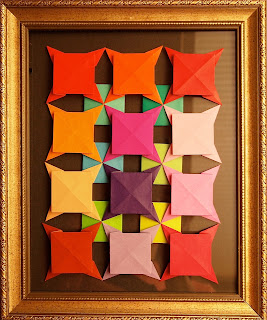These dual Boston Commons quilt tops were made with the same fabrics in each (the colors are different because the pictures were taken at different times of day). Each quilt is approximately 42 x 54 inches. This is the size we use for our church charity quilts. I have always wanted to make a Boston Commons quilt, and of course I wanted to strip piece it. Because there are different numbers of squares of each color, the only way to make strip piecing work is to make two of them. It turns out these are much easier to strip piece than the dual trip around the world quilts, which I tried to explain
here. If there are any problems or questions about these instructions, please leave a comment.
Choose eight fabrics - selvage to selvage (not fat quarters). You will need more than 1/2 yard - at least 5/8 yard. Number the fabrics 1 to 8. In this picture, number 1 is on the left and number 8 is on the right. Number 8 will be the fabric that forms the "border."
Cut four strips 4 3/4 inches wide from selvage to selvage of fabrics 1 to 7.
Cut four strips 5 1/2 inches wide from fabric 8. The extra width is needed for the additional seam allowance along the diagonal.
Sew half of the strips in pairs: 1 & 2, 3 & 4, 5 & 6, 7 & 8, so that there are two pairs of each. Note: either press all seams towards odd numbered fabrics, or press all seams towards even numbered fabrics.
Sew the other half of the strips in pairs: 2 & 3, 4 & 5, 6 & 7, 8 & 1.
Cut the first set of pairs into two halves, each slightly longer than 19 inches. Sew them together so that there are four different sections with the fabrics in the following order:
1 - 2 - 3 - 4 - 5 - 6 - 7 - 8
3 - 4 - 5 - 6 - 7 - 8 - 1 - 2
5 - 6 - 7 - 8 - 1 - 2 - 3 - 4
7 - 8 - 1 - 2 - 3 - 4 - 5 - 6
This is a picture of those four sections, overlapped, from top to bottom.
Cut the second set of pairs into two halves, each slightly longer than 19 inches. Sew them together so that there are four sections in the following order:
2 - 3 - 4 - 5 - 6 - 7 - 8 - 1
4 - 5 - 6 - 7 - 8 - 1 - 2 - 3
6 - 7 - 8 - 1 - 2 - 3 - 4 - 5
8 - 1 - 2 - 3 - 4 - 5 - 6 - 7
Cut four strips from each section, 4 3/4 inches wide. Arrange them so that the top row starts with fabric #1, second row starts with fabric #2, etc.
Sew the rows together. Not all the cross seams will match up, because fabric 8 is wider. Note: don't press seams, or press seams lightly all in the same direction. When the quilts are assembled, we will want seams to alternate pressed towards odd numbered rows on one quilt and even numbered rows on the other quilt. We have to cut the panels apart first.
Cut the panels apart along the diagonal. The cut should go straight through the middle and should be 1/4 inch from the points of the squares on either side.
Arrange four identical triangles so that the center squares of the side triangles overlap, and the end triangles match up. Decide on the best arrangement and remove one square from one of the sides. Open the seam between rows about an inch and a half more than is needed to remove the block.
Now the large triangles will be sewn together. Make sure that the point where the 1/4 inch seam allowances meet lines up with the seam between the last square and the end triangle. Mark the seam allowances if you have to.
Sew the two end triangles to the sides of the side triangle that has the center removed. At this point you can figure out which way to press the long seams so that the cross seams interlock.
Sew one edge of the remaining side triangle to the edge of the other side that was detached when the center square was removed.
Sew the last pair of inside edges together.
Cut off the corners.
Repeat this with the other four triangles, and you have two beautiful quilt tops.
 I've finished another quilt at the eleventh hour. This was the UFO for November. I had a hard month and did very little quilting, so I thought I would make the effort to finish it by the end of the year. And I did! So I finished all twelve of my UFOs, not exactly on schedule, but close.
I've finished another quilt at the eleventh hour. This was the UFO for November. I had a hard month and did very little quilting, so I thought I would make the effort to finish it by the end of the year. And I did! So I finished all twelve of my UFOs, not exactly on schedule, but close.





























































